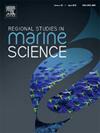Dynamics of biogeomorphology and CO2 sequestration in Jiangsu’s coastal salt marshes in East China following Spartina alterniflora invasion during 20112022
IF 2.1
4区 环境科学与生态学
Q3 ECOLOGY
引用次数: 0
Abstract
Coastal wetland ecosystems are important blue carbon sinks that are vulnerable to human activity, geographical changes, and ecological invasion. China’s coastline has been invaded by Spartina alterniflora stemming from its artificial introduction (Jiangsu Province is a hotspot). Understanding the bio-geomorphic changes and carbon dynamics in invaded coastal ecosystems is of great significance. In this study, a coupled model was established and validated to explore vegetation community dynamics, topographical changes, and CO2 fluxes in Jiangsu Province coastal salt marshes from 2011 to 2022. Both the measured and modeled results showed that the total vegetation area of the salt marshes continued to increase during the last decade, and the S. alterniflora area increased rapidly from 88.79 to 120.51 km2, accounting for 73.52 %. The area dominated by native Phragmites australis increased slightly, whereas that dominated by Suaeda glauca decreased rapidly. The simulated sedimentation rates in the salt marshes generally matched the monitored data in the northern and central regions of the Jiangsu coastline. The S. alterniflora invasion promoted flat accretion due to its rapid range expansion and strong sediment-trapping ability. The model described the variations in the CO2 fluxes of different vegetation types in salt marshes on daily, monthly, and annual scales. The calculation of gross CO2 sequestration demonstrated that Jiangsu’s coastal salt marshes possess robust carbon sink capabilities, with average amounts of 289,727.66 TC year−1 of gross primary production (GPP) and 193,440.07 TC year−1 of net ecosystem exchange (NEE). S. alterniflora marshes were the primary contributors to GPP (∼87 %) and NEE (∼88 %). Our results are helpful for assessing or predicting the effects of invasive species on the bio-geomorphic changes and carbon sink capacities of coastal wetlands, as a deliberate management strategy for invasive species control.
求助全文
约1分钟内获得全文
求助全文
来源期刊

Regional Studies in Marine Science
Agricultural and Biological Sciences-Ecology, Evolution, Behavior and Systematics
CiteScore
3.90
自引率
4.80%
发文量
336
审稿时长
69 days
期刊介绍:
REGIONAL STUDIES IN MARINE SCIENCE will publish scientifically sound papers on regional aspects of maritime and marine resources in estuaries, coastal zones, continental shelf, the seas and oceans.
 求助内容:
求助内容: 应助结果提醒方式:
应助结果提醒方式:


